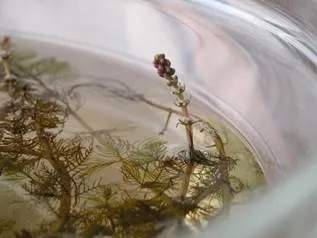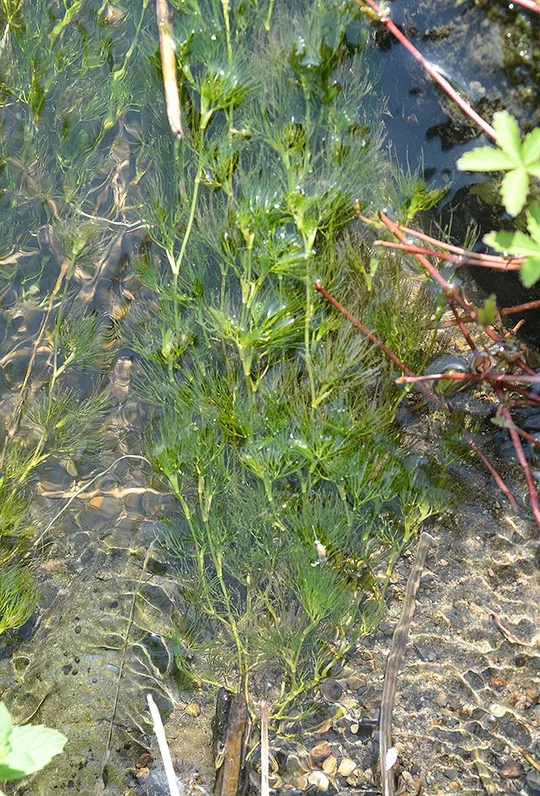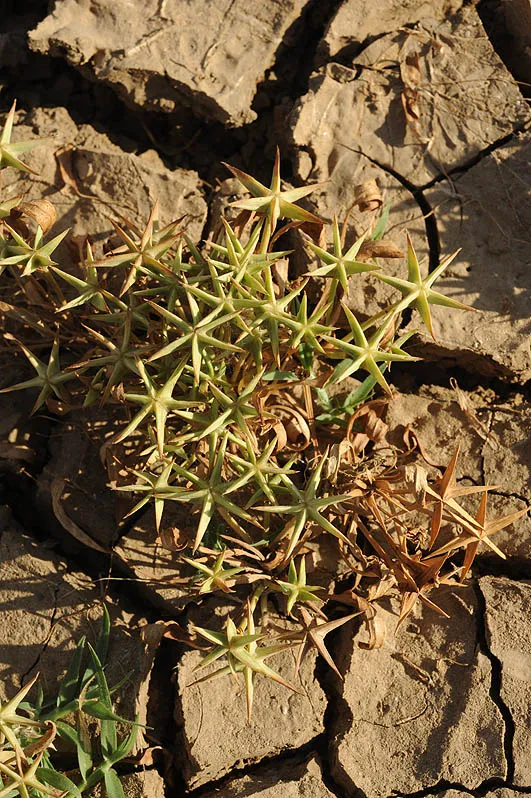Eurasian Water-milfoil, Spiked Water-milfoil
Myriophyllum spicatum


Myriophyllum spicatum is a submersed perennial aquatic plant whose rhizome’s outer casing is spongy and soft. Stems long, reddish, with adventitious roots branching out from their nodes. Unlike Ceratophyllum demersum, a similar submersed species, whose leaves are forked, M. spicatum leaves are pinnate and the leaflets are threadlike. The terminal flowering spikes protrude above the water. The flowers are monosexual – male flowers at the top of the inflorescence and female ones at its base. The perianth is papery and greenish-white. The male flower has 4 sepals, 4 petals and 8 stamens. The female flower has a four-lobed calyx, a tiny corolla and 4 carpels that develop into 4 mericarps in the fruit. The flowers are wind-pollinated. The fruit mericarps split when ripe, float for a few hours and then sink in the water. The seeds are eaten by birds. Germination requires sunlight. Vegetative reproduction is also very common, and detached plant parts can take root and grow independently.
Myriophyllum spicatum once grew in lakes, streams, brooks
and swamps in the Hula Valley, Kinarot Valley (the Sea of Galilee), Jordan
Valley and the Sharon (the Yarkon and Taninim Stream). After 1980, it was still
found occasionally in a number of locations in the Dan Stream, in the Bet tsayda
Valley and at the Yarkon River sources. New sites have been found in the Carmel
Coast region (Dalya Swamps and Difla Stream ) and Ramot Menashe (Hashrat
Spring), which were not known in the past. Some of the new locations (post-1965)
are probably new, natural colonizations, resulting from long-distance dispersal
by aquatic birds. In 2005, a dense population of the plant was sighted in the
upper Galilee at the Dalton Pond (Talia Oron). According to Saul Beckerman, the
only location where natural populations definitely grow is the Shabanie Reservoir;
the source of other populations is from aquarium plants.
Lakes and permanent
freshwater bodies. Before the drainage, M. spicatum was once the
dominant species in Hula plant communities (Zohary and Orshansky, 1947) and in the
Sea of Galilee (Waisel, 1967).
The genus Myriophyllum
has 40 species, most of which have a cosmopolitan distribution.
·
The
drainage of the Hula marshes and the deterioration of and reduction of water bodies
in the Hula Valley, wiped out most of the M. spicatum populations. The increasing salinization of the Sea of
Galilee during the 1960s and 70s, the modified water level and the pressure
from bathers almost completely eradicated the species from the Sea of Galilee, where
it was once the dominant species in the immersed plants community. The drop in
the water level and its fluctuation may threaten the populations in the Bet
tsayda Valley as well.
·
M. spicatum populations that now grow in natural water bodies,
whether their source is natural or from aquariums, are very isolated from each
other.
·
Although
Myriophyllum spicatum is a red species in Israel, threatened by the
reduction of freshwater bodies, it apparently is not globally endangered.
Furthermore, it is a very aggressive invasive plant in North America, where intensive
efforts are invested to limit its propagation.
·
Protected
in the Bet tsayda Valley and the Yarkon and Tel Afek National Park Park.
Myriophyllum spicatum should be naturalized in the Hula Reserve and Agamon
HaHula and reintroduced to the Sea of Galilee; the population at the Sources of
the Yarkon Park should be strengthened.
Its natural distribution
area is in Mediterranean countries, Europe and western Asia. From the 1940s, it
appeared in water bodies in America as well, apparently having arrived via
ballast water from ships or by “escaping” from aquariums. In the United States,
it is a problematic invasive plant that grows very densely in canals, pools and
other bodies of water due to its rapid vegetative reproduction. It causes
blockages in pumps, interferes with recreational activities, prevents boating,
competes with the local immersed aquatic plants and disturbs the functioning of
the original aquatic ecosystem.
Myriophyllum spicatum is a species whose populations have
drastically decreased as a consequence of the reduction in the number of water
bodies and the deterioration of water quality. The danger is only local,
because the plant is very common globally. In America, it is an invasive plant
and efforts are actually being made there to suppress it. Naturalizing the
plant in nature reserves with water bodies and suitable aquatic growing sites
should be considered.
ויזל, י. וליפשיץ, נ. 1971. צמחי מים בישראל. הוצאת רשות שמורות הטבע.
Waisel. Y. 1967. A contribution to the knowledge of the phanerogamous vegetation of Lake Tiberias. Sea Fish res. Sta. Haifa Bull. 44: 3-16.
אתרי אינטרנט:
Washington State Department of Eogy: Water Quality Program:
http://www.ecy.wa.gov/programs/wq/plants/plantid2/descriptions/myrspi.html
california invasive Plants Council:
http://ucce.ucds.edu/datastore/detailreport.cfmusernumber65&surveynumber182
Current Occupancy Map
| 1000 squre meter pixel | 5000 squre meter pixel | 10000 squre meter pixel | |
|---|---|---|---|
| number of observations | 0 | 0 | 0 |
| in total pixels | 0 | 0 | 0 |
| Family | Haloragaceae |
| Classification | On the endangered species list |
| Ecosystem | Mediterranean humid |
| Chorotype | Euro – Siberian, Mediterranean, Irano-Turanian |
| Conservation Site | Shabanie Reservoir |
| Rarity |
1
3
6
|
|---|---|
| Vulnerability |
0
4
4
|
| Attractiveness |
0
0
4
|
| Endemism |
0
0
4
|
| Red number |
1
3.7
10
|
| Peripherality | 0 |
| IUCN category | DD EW EX LC CR EN VU NT |
| Threat Definition according to the red book | Vulnerable |
 Based on:
Based on:






